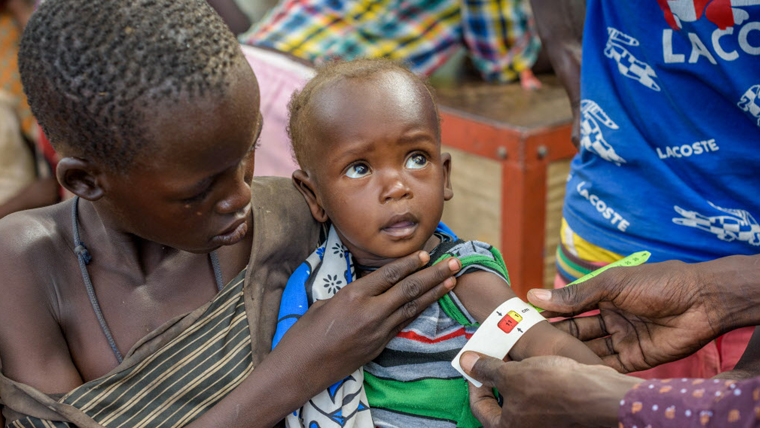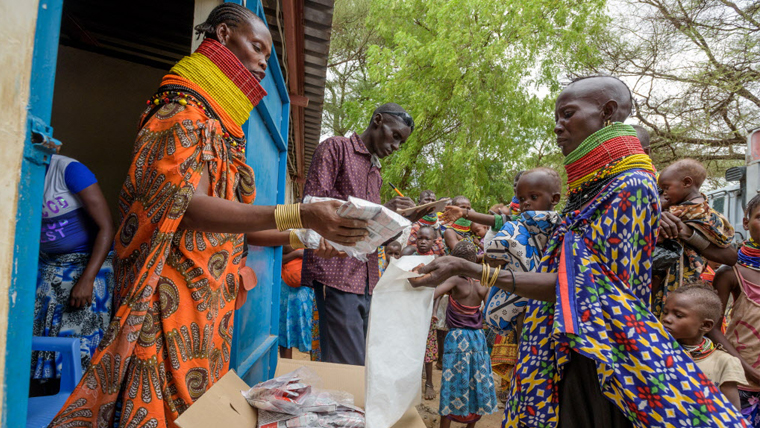Sleeping into death - the cost of drought in Kenya
By Kari Costanza
Baby Akusi was showing visible signs of wasting when she was brought to the clinic in Turkana County, Kenya. Her mother, Lomukuny, was worried by her orange hair and diarrhoea. Her baby, born in September 2016 wasn’t thriving and Lomukuny knew why. “The baby is affected by drought,” she said. “When I was pregnant, I had nothing to eat.”
Lomukuny named her child “wind”. “When the drought started, it started with a wind. I named her after the wind,” said Lomukuny. “The baby is affected by the drought.”

Turkana is located just 18 miles from the border with South Sudan. The people there are suffering, living through drought and conflict.
Children like 9-month-old Akusi are wasting away. The Global Acute Malnutrition rate, which indicates the severity of a hunger crisis, is 30% in Turkana right now.
“In 100 children, 30 of them are wasted,” explained Lydia Ndung’u, a nutritionist with World Vision. “When a child is wasted, they have lost muscle and fat mass.” Visible signs include a change in hair colour and skin lustre. Wasting, said Lydia, is a strong predictor of death in children under 5.
Lomukuny’s pregnancy had been hard. She had four other children and had just moved villages. “We moved here last year,” she said. “We used to live near the border with our animals, five cattle and 10 goats. Not even one remains.”
People in Turkana are pastoralists. It’s a beautiful life when there is rain to grow grasses for their camels, cows, donkeys, sheep, and goats to eat. They live simply. Children play. Their parents dance and sing. Families are close. They pray together. But after a succession of droughts, life is no longer beautiful. It’s a nightmare.
Drought has bred conflict over animals, the income source for pastoralists in Turkana. “My husband was killed by bandits,” said Lomukuny. Cattle raiders from South Sudan came across the border to the family home in Nadapal, killed her husband, and took most of the family’s animals. The remaining animals died from the drought.
Lomukuny was left a single mother of four children between three and twelve, and pregnant with a child who would never know her father. They were forced to leave to find help.
“We walked here, carrying our luggage on our heads,” she said. It took two days to walk the 20-mile distance, bringing very little of their belongings with them. “We had empty gourds,” she said. “I couldn’t carry much,” she said. “I was pregnant. I left my utensils behind.” Without a source of income for food, Lomukuny became malnourished and unwell. “You are hungry and then you get sick,” she said.
On arrival at the health clinic, Akusi was weighed, measured, and scored. Children are given what is called a z-score, based on their height and weight. Zero is normal. Akusi’s z-score was -3. She was severely malnourished and immediately given Ready-to-use Therapeutic Food, known as plumpy’nut, supplied by World Vision through the World Food Program. Lomukuny was also asked to come back the next day to receive a Corn Soy Blend mix supplied by World Vision through the World Food Program to help with her malnutrition.

Plumpy’nut is a high-protein peanut paste that, if administered properly by caregivers, can take a child from severe malnutrition to good health in a matter of weeks.
Akusi arrived at the clinic just in time, said World Vision nutritionist June Cherutich. “What would happen if she hadn’t received plumpy’nut today?” wondered June aloud. “She would probably have deteriorated. She would have died of dehydration or diarrhoea,” said June. “Akusi would have just slept into death.”
Clinic nutritionists Stella Akai and Alice Akal said that plumpy’nut is a miracle cure. “It is the best,” said Alice. “It is saving their lives.” Stella added: “It really works. If they didn’t have the plumpy’nut, they would be hospitalized.”
The clinic was teeming with crying children and their worried mothers. The drought in East Africa has caused the number of patients at this clinic to skyrocket, said head nurse Jonah Ekutan. In Somalia, Ethiopia, and South Sudan situation is the same.
“Right now we have 850,000 malnourished children in East Africa,” said Christopher Hoffman, who runs World Vision’s East Africa response. “Without immediate action, between 30% and 50% of these children will die.” During the 2011 hunger crisis in Somalia, most of the deaths happened between May and July.
Akusi and her mother went home with plumpy’nut and Lomukuny was instructed in how to use them, giving her three packets a day.

But plumpy’nut must be used properly. “If the baby doesn’t eat the whole dose, they won’t get well,” said Alice.
The rapidly deteriorating situation in the region means supplies of plumpy’nut are not keeping up with demand. “We don’t have enough plumpy’nut,” explained Alice. “We are getting a two-week supply that just lasts a month,” she said.
That’s not good news for babies like Akusi who need their full dose of plumpy’nut to recover. And it’s not good news for hundreds of thousands of children across East Africa who face the same fate.
Akusi was named for the wind that was blowing at the time of her birth. Now she faces a storm that will not abate without the world coming together to respond.
Find out how you can support our work in East Africa.